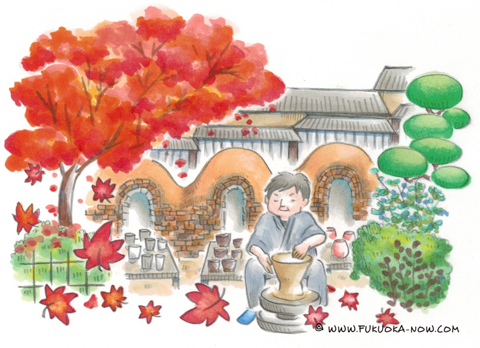Hakata Culture vol.129
Takatori Ware: The City's Last Remaining Stoneware

Located in Sawara Ward, Mirakugama is Takatori ware kiln celebrating its 300th anniversary this year. Miraku Kamei, the 15th-generation owner, continues making traditional pottery together with his son, who is scheduled to succeed him. Takatori ware flourished in the Edo era under the patronage of the Kuroda Clan, and Mirakugama is now the only kiln that remains inside the city limits.
The stoneware traces its roots back to a potter named Hassan who was brought back from the Korean Peninsula by Nagamasa Kuroda, the first lord of the Fukuoka Domain. He opened his first kiln in 1606 at the foot of Mt. Takatori in what is now Nogata City. Hassan was granted samurai status and took the name Hachizo Takatori, and later, his stoneware would become known as Takatori ware.
The Takatori ware kiln moved several times over the years, and the potting style changed each time. The first generation of Takatori ware that was created near Mt. Takatori exudes a more rustic beauty, and these pieces are known as Old Takatori. When Tadayuki Kuroda succeeded his father as the second lord of the domain, he sent Hachizo to study teaware under the renowned potter Kobori Enshu. As such, Takatori ware from this period is called Enshu Takatori, and it is typified by a more refined style. Hachizo's kiln soon came to be counted among Enshu’s top seven favorite kilns, the so-called Enshu Nanagama.
Later, the kiln was relocated to Toho Village in Asakura District, and pieces from this era are called Koishiwara Takatori. During the time of Tsunamasa, the domain’s fourth lord, the Takatori ware kiln moved again, this time to a spot not far from Fukuoka Castle. By this time, the kiln was being run by Hachizo’s descendants and pupils, and the current Mirakugama traces its history back to this time. Mirakugama has a museum space where it exhibits Old Takatori and other pieces, and it also offers occasional pottery classes. Why not stop by and try your hand at potting?
市内に唯一残る福岡藩の御用窯・高取焼
福岡市早良区にある高取焼味楽窯は、江戸時代に窯が開かれて今年で300年を迎えた伝統ある窯元です。現在は第15代の亀井味楽さんが、第16代を継ぐ予定の息子さんと一緒に焼き物を作り続けています。高取焼は福岡藩の御用窯として知られていますが、現在も市内にあって作陶しているのは味楽窯だけになりました。
高取焼のルーツは、初代福岡藩主の黒田長政が朝鮮半島から陶工・八山を連れ帰ったことに始まります。1606年に、現在の福岡県直方市の鷹取山の麓に八山が最初の窯を開きました。八山は武士の身分を与えられ、この鷹取山にちなんだ姓「高取」をもらって、高取八蔵と名のるようになります。これが高取焼の名称の由来で、以降、福岡藩の御用窯として続いていくことになります。
長い歴史の中で、高取焼はあちこちに移転し、その作風も時代とともに変わっていきます。鷹取山の周辺で焼かれていた初期の高取焼は野趣あふれる作風で、この時代のものを「古高取」と呼びます。2代藩主・忠之は、八蔵を茶人として名高い小堀遠州のもとにつかわして、遠州好みの茶器を学ばせます。この時代の高取焼は「遠州高取」と呼ばれ、より洗練された雰囲気が特徴です。高取焼は遠州好みの焼き物をつくる「遠州七窯」のひとつに数えられるようになりました。
窯はさらに現在の福岡県朝倉郡東峰村に移転し、この時代のものを「小石原高取」と呼ぶこともあります。4代藩主・綱政の時代に、高取焼は福岡の城下町に呼ばれて市内に窯を開くことになりました。八蔵の子孫や弟子たちが市内に窯を構えますが、この流れを汲むのが現在の味楽窯です。味楽窯には古高取などを展示する美術館があり、陶芸教室なども開催されています。

